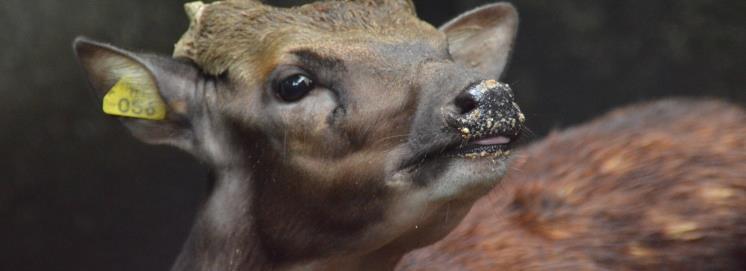
4 minute read
Negros’ Big Five
from Green Spaces
Written By: MARC ANDREW GEOLINGO | Photos by: MARC ANDREW GEOLINGO and CARLO B. BAIS
Wildlife is all around us, in the vastness of the ocean and the in the smallest particle of dust, life exists. Here in Negros Island we are so blessed with the wonderful wildlife we have. The Negros Big 5 represents our rich biodiversity because of their fundamental role in rehabilitating our Island. These endemic animals are bio-indicators of a healthy forest, that is why much attention is given to these individuals. With the growing population of humans, their number is critically declining. Negros Big 5 is here to give us an idea of what biodiversity conservation should look like. That is why we should be aware of what they are facing and that they need our help.
Advertisement
Visayan Spotted Deer

The Visayan Spotted Deer (Rusa alfredi) once roamed the rainforests of Panay and Negros Islands. Now, it is listed as critically endangered species due to habitat disruption and hunting, leaving only small pockets of them living in protected areas in the wild. These deer are nocturnal, preferring to forage for food at night. They are easily distinguished by their spotted white pattern peppering their brown coat and cream colored underside. Though at critically low population levels, the deer are making good progress in repopulating due to breeding programs being done in Negros Forest Park which helps pull this majestic animal back from the brink.
Visayan Warty Pig

The Visayan Warty Pig (Sus cebifrons) may look like intimidating with its big tusks and large robust bodies but in reality they are shy animals choosing to avoid humans when they can, and for good reason. Visayan Warty Pigs are critically endangered being almost completely absent from their historic range of Panay and Negros due to excessive poaching for meat as well as increasing habitat loss. These Pigs are endemic to Negros and Panay. The Visayan Warty Pig is critically endangered and at high risk of extinction but with the help of breeding efforts such as the one undertaken at Negros Forest Park which is helping to preserve these exquisite piggies.
Negros Bleeding Heart Pigeon
The Negros Bleeding Heart Dove (Gallicolumba keayi) is known for its green shimmering iridescence on its head while its back, wings, and tail having a light brown color to them, its underbelly is white with one bright red streak of crimson running down the chest of this beautiful bird giving it its name. Sadly the Negros Bleeding Heart Dove is critically endangered as populations of these birds become scarcer every year. These birds are endemic to the Negros Islands. They suffer from over hunting and habitat loss as forest cover in Negros degrades. The Negros Bleeding Heart is on its last legs. In much of its historic range the Dove has been missing, but through continued conservation and breeding programs we might see this beautiful bird hop and hobble around the forests of Negros once again.
Visayan Hornbill
The Visayan Hornbil (Penelopides panini) is an endemic species stretching from Panay, Negros, Masbate and Guimaras. The other name “Taictic Hornbill” are named after the unique sounds they make. They show sexual dimorphism. The females have a very dark body with white markings on its tail where as the male hornbill has white along its underbelly, tail, and head. When breeding the couple are bonded for life, they breed inside crevasses of trees. Currently the species faces uncertainty as poaching and habitat loss has made the species endangered. With proper care, love, and passion we can bring back the cry of these beautiful creatures back to the canopies of our forests.
Rufous Headed/ Walden’s Hornbill
The Rufous Headed Hornbill (Rhabdotorrhinus waldeni) also known as the Walden’s hornbill, one of the most critically endangered animal on the list with only a handful of pairs in Negros. This endemic species of hornbill is at the brink of extinction in its native land. The Walden’s Hornbill sports a black body with a brown neck for males and a dark neck for females. The faces are also different depending on the sex of the individual bird as males have a bright pastel yellow face while females have a powder blue colored face. Sporting an impressive orange beak with grooves on its lower beak and an impressive ridge at the top of its head make the Walden’s Hornbill a graceful bird. That allure has attracted poachers from the exotic pet trade as well as trophy hunters. Luckily there is hope as breeding projects are helping maintain their populations. Most notably in Negros Forest Park on February 14, 2019 they were able to successfully breed a Walden’s Hornbill chick named “Valentine”. The first Walden’s hornbill bred in over 6 years. Although one hornbill isn’t enough to completely save the species but its small steps like these that give us hope for their future.








